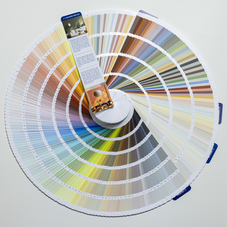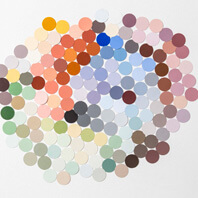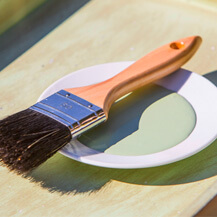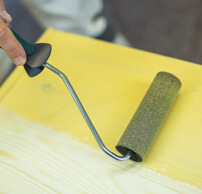Walls and ceilings
Please observe the following when using the AURO smoothing technique: In addition to the desired lime tinting base, approx. 5-10 % of the gypsum-based Natural wall filler no. 329 should be added to the mixture for the first application.
First mix the desired amount of lime tinting base with water. When adding a higher amount of lime tinting base for stronger colour shades, a smaller amount of water should be used because the lime tinting base dilutes the filling compound. Then mix High-grade lime filler no. 342 and Natural wall filler no. 329 dry before adding the water/lime tinting base mixture while constantly stirring. Allow the filling compound to mature shortly and stir again after approx. 2 minutes before use. Please note that the workable life of the filling compound is shorter when adding Natural wall filler no. 329. Only mix as much material as can be applied within 45-60 minutes.
A light colour shade of filling compound can e.g. be mixed as follows:
- High-grade lime filler no. 342 - 3 kg
- Natural wall filler no. 329 - 200 g
- Lime tinting base no. 350 - 0.125 l
- Water - 1.7 l (approx.)
A strong colour shade of filling compound can e.g. be mixed as follows:
- High-grade lime filler no. - 342 3 kg
- Natural wall filler no. 329 - 200 g
- Lime tinting base no. 350 - 1 l
- Water - 1.4 l (approx.)
The aforementioned quantities of water added to the filling compound are approximate values only. The filling compound can be thickened or diluted according to the user's preference.
In general it is better to initially use a little less water because water can always be added to the mixture at a later point of time, should the mixture turn out to be too 'thick'.
Reason for adding Natural wall filler no. 329:
Adding Natural wall filler no. 329 improves adhesion on the one hand and, above all, makes the first filler layer slightly harder than the subsequent filler layer applied without adding Natural wall filler no. 329.
This is an important factor when using the smoothing technique:
The second layer (without adding no. 329) is highly compressed by means of a Venetian trowel which is why surface tension resulting from the drying process, which may ultimately lead to delamination, may occur under certain conditions. Rather soft substrates pose a higher risk of delamination. This is why loam plaster is absolutely unsuitable for the smoothing technique. In practice, it has proven successful to work from "hard to soft", i.e. to make the first filler layer a little harder by adding gypsum. This method prevents all adhesion problems.




